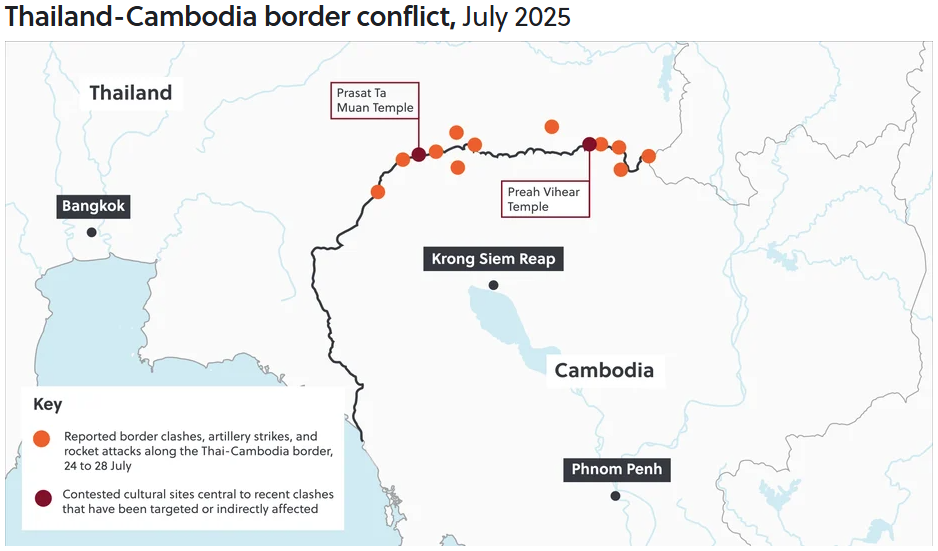Beyond borders: The domestic dynamics behind the Thailand-Cambodia clash
In July 2025, a decades-old border dispute between Thailand and Cambodia once again flared into open conflict. Over five days, Thai and Cambodian forces clashed close to contested cultural sites and temples, including the Prasat Ta Muen Thom temple, and the Preah Vihear temple further east along the border. At least 43 people were killed during the conflict, and hundreds of thousands of residents were displaced from towns and villages on both sides. On 28 July, Thailand and Cambodia agreed to a ceasefire mediated by the Association of Southeast Asian Nations (ASEAN, currently chaired by Malaysia) and the US. Barring sporadic landmine explosions, and accusations of breaches from both sides, the agreement has held. This confrontation was not an isolated incident, but rather the latest development along a frontier of national pride and political power for both countries.

Longstanding border tensions
Open hostilities between these two countries are rare – particularly at the scale of recent events – but they form part of a historic dispute (dating back to the 1900s) over their undesignated border and sensitive historic sites like the Preah Vihear temple, over which both sides claim historic ownership. Despite the International Criminal Court assigning the temple to Cambodia’s jurisdiction in 1962, the two countries occasionally clash over these sites, with sporadic fighting between 2008 and 2011 resulting in 16 deaths and 36,000 people displaced. Prior to the most recent confrontation, tensions had been brewing for months; after a minor altercation between opposing border guards in February, tit-for-tat manoeuvres on both sides eventually escalated into a brief exchange of fire on 28 May. This initial skirmish was isolated, and soon quelled through diplomatic channels, but it nevertheless provoked deep-seated nationalist sentiment among the public and political establishments in both countries. Bilateral tensions ramped up over the weeks that followed, with both countries employing retaliatory diplomatic measures; Thailand imposed restrictions on cross-border travel and trade, and cut electricity and internet supply to Cambodia, while Cambodia closed border crossings, and banned Thai food and fuel imports, as well as Thai broadcasting on local stations.
Domestic and strategic calculations
Behind the escalating nationalist rhetoric from both sides, and the decline in cross-border trade, however, were homegrown political challenges and economic considerations that factored into Thailand and Cambodia’s decision-making around the dispute, setting the stage for the military confrontation that followed. For Thailand, the initial border clash on 28 May – followed by a controversial phone call between Thai Prime Minister Paetongtarn Shinawatra and Cambodian Senate President Prime Minister Hun Sen – exposed the fragility of Thailand’s coalition government, and deep divisions between the progressive Pheu Thai Party and the military establishment. The military had incentive to project a strong and capable response to the border issue in order to undermine its political opponents in government, driving its armed response and strong rhetoric towards Cambodia. But despite this posturing, Thailand likely has a low appetite for an expansive war. Thailand’s airstrikes, involving heavy – and sometimes controversial – weapons like cluster bombs, targeted specific military bases in areas from which it believed Cambodia launched attacks, and while this impacted cultural sites nearby, it suggested an effort to avoid wider damage and casualties.
Factoring into Cambodia’s calculations, the country’s leaders were no doubt also responding to recent Thai decisions that directly impact Cambodia’s economy, alongside rising border tensions; namely, Thailand’s clampdown on scam centres and illegal timber smuggling, and uncertainty around Thai casino legislation, that threaten to disrupt high-value revenue streams for Cambodian elite. Meanwhile, Senate President Hun Sen, a highly influential figure in Cambodia’s political landscape, has leveraged the border clashes to stoke nationalist sentiment and consolidate public support for himself and his son, current Prime Minister Hun Manet. However, compared to Thailand, Cambodia’s military is only about a third of the size, and lacking in advanced weaponry, which makes it unlikely to mount – or win – a full-scale, direct confrontation.
US and international pressure
The US, Malaysia and China all played a part in mediating the 28 July ceasefire, but it was trade pressure from the US that reportedly had the greatest effect. Both Thai and Cambodian exports faced potential US tariffs of 36 percent under US President Donald Trump’s new trade regime, had they failed to negotiate a better deal with the US before a deadline of 1 August. Trump had spoken to both Thai and Cambodian leaders days prior to formal ceasefire talks in Malaysia, threatening to suspend trade negotiations until the fighting stopped. International pressure from key trading partners, including the US, China and ASEAN, will continue to dampen the appetite for war on both sides.
Border pressures persist
Neither Thailand nor Cambodia wants an inter-state war that reaches their capital cities and major urban areas, and, combined with economic leverage from abroad, the 28 July ceasefire is likely to hold over the coming months, at least. However, certain domestic dynamics – particularly strong nationalist feeling around the border issue, fuelled by hardline, pro-military elements in both countries – will continue to obstruct progress towards a permanent resolution to the dispute. Moreover, the highly militarised nature of the border area, alongside the degradation of diplomatic channels, will sustain the potential for further misunderstandings between troops to escalate into another direct clash. Thus, tensions are likely to continue to simmer below the surface for many years to come, leading to periodic break-downs in bilateral relations and commercial cooperation, increasing militarisation and posturing in sensitive areas, and sporadic – but geographically contained – skirmishes along the border.
